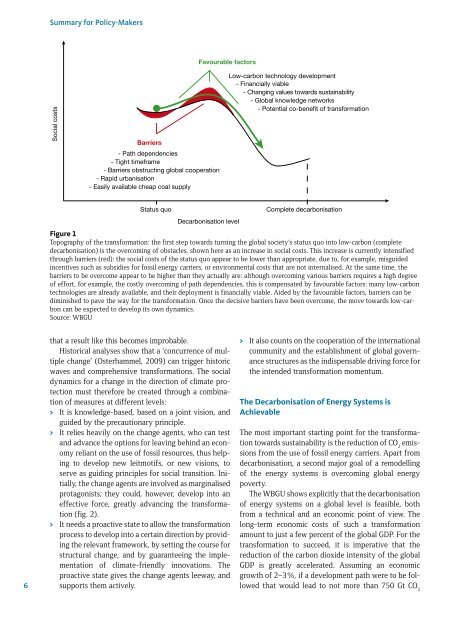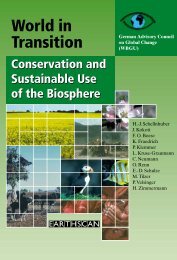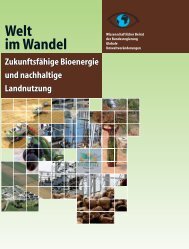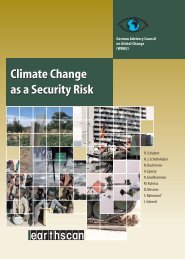World in Transition: A Social Contract for Sustainability - WBGU
World in Transition: A Social Contract for Sustainability - WBGU
World in Transition: A Social Contract for Sustainability - WBGU
You also want an ePaper? Increase the reach of your titles
YUMPU automatically turns print PDFs into web optimized ePapers that Google loves.
6<br />
Summary <strong>for</strong> Policy-Makers<br />
<strong>Social</strong> costs<br />
Barriers<br />
- Path dependencies<br />
- Tight timeframe<br />
- Barriers obstruct<strong>in</strong>g global cooperation<br />
- Rapid urbanisation<br />
- Easily available cheap coal supply<br />
Status quo<br />
Favourable factors<br />
Decarbonisation level<br />
Figure 1<br />
Topography of the trans<strong>for</strong>mation: the first step towards turn<strong>in</strong>g the global society’s status quo <strong>in</strong>to low-carbon (complete<br />
decarbonisation) is the overcom<strong>in</strong>g of obstacles, shown here as an <strong>in</strong>crease <strong>in</strong> social costs. This <strong>in</strong>crease is currently <strong>in</strong>tensified<br />
through barriers (red): the social costs of the status quo appear to be lower than appropriate, due to, <strong>for</strong> example, misguided<br />
<strong>in</strong>centives such as subsidies <strong>for</strong> fossil energy carriers, or environmental costs that are not <strong>in</strong>ternalised. At the same time, the<br />
barriers to be overcome appear to be higher than they actually are: although overcom<strong>in</strong>g various barriers requires a high degree<br />
of ef<strong>for</strong>t, <strong>for</strong> example, the costly overcom<strong>in</strong>g of path dependencies, this is compensated by favourable factors: many low-carbon<br />
technologies are already available, and their deployment is f<strong>in</strong>ancially viable. Aided by the favourable factors, barriers can be<br />
dim<strong>in</strong>ished to pave the way <strong>for</strong> the trans<strong>for</strong>mation. Once the decisive barriers have been overcome, the move towards low-carbon<br />
can be expected to develop its own dynamics.<br />
Source: <strong>WBGU</strong><br />
that a result like this becomes improbable.<br />
Historical analyses show that a ‘concurrence of multiple<br />
change’ (Osterhammel, 2009) can trigger historic<br />
waves and comprehensive trans<strong>for</strong>mations. The social<br />
dynamics <strong>for</strong> a change <strong>in</strong> the direction of climate protection<br />
must there<strong>for</strong>e be created through a comb<strong>in</strong>ation<br />
of measures at different levels:<br />
> It is knowledge-based, based on a jo<strong>in</strong>t vision, and<br />
guided by the precautionary pr<strong>in</strong>ciple.<br />
> It relies heavily on the change agents, who can test<br />
and advance the options <strong>for</strong> leav<strong>in</strong>g beh<strong>in</strong>d an economy<br />
reliant on the use of fossil resources, thus help<strong>in</strong>g<br />
to develop new leitmotifs, or new visions, to<br />
serve as guid<strong>in</strong>g pr<strong>in</strong>ciples <strong>for</strong> social transition. Initially,<br />
the change agents are <strong>in</strong>volved as marg<strong>in</strong>alised<br />
protagonists; they could, however, develop <strong>in</strong>to an<br />
effective <strong>for</strong>ce, greatly advanc<strong>in</strong>g the trans<strong>for</strong>mation<br />
(fig. 2).<br />
> It needs a proactive state to allow the trans<strong>for</strong>mation<br />
process to develop <strong>in</strong>to a certa<strong>in</strong> direction by provid<strong>in</strong>g<br />
the relevant framework, by sett<strong>in</strong>g the course <strong>for</strong><br />
structural change, and by guarantee<strong>in</strong>g the implementation<br />
of climate-friendly <strong>in</strong>novations. The<br />
proactive state gives the change agents leeway, and<br />
supports them actively.<br />
Low-carbon technology development<br />
- F<strong>in</strong>ancially viable<br />
- Chang<strong>in</strong>g values towards susta<strong>in</strong>ability<br />
- Global knowledge networks<br />
- Potential co-benefit of trans<strong>for</strong>mation<br />
Complete decarbonisation<br />
> It also counts on the cooperation of the <strong>in</strong>ternational<br />
community and the establishment of global governance<br />
structures as the <strong>in</strong>dispensable driv<strong>in</strong>g <strong>for</strong>ce <strong>for</strong><br />
the <strong>in</strong>tended trans<strong>for</strong>mation momentum.<br />
The Decarbonisation of Energy Systems is<br />
Achievable<br />
The most important start<strong>in</strong>g po<strong>in</strong>t <strong>for</strong> the trans<strong>for</strong>mation<br />
towards susta<strong>in</strong>ability is the reduction of CO 2 emissions<br />
from the use of fossil energy carriers. Apart from<br />
decarbonisation, a second major goal of a remodell<strong>in</strong>g<br />
of the energy systems is overcom<strong>in</strong>g global energy<br />
poverty.<br />
The <strong>WBGU</strong> shows explicitly that the decarbonisation<br />
of energy systems on a global level is feasible, both<br />
from a technical and an economic po<strong>in</strong>t of view. The<br />
long-term economic costs of such a trans<strong>for</strong>mation<br />
amount to just a few percent of the global GDP. For the<br />
trans<strong>for</strong>mation to succeed, it is imperative that the<br />
reduction of the carbon dioxide <strong>in</strong>tensity of the global<br />
GDP is greatly accelerated. Assum<strong>in</strong>g an economic<br />
growth of 2–3 %, if a development path were to be followed<br />
that would lead to not more than 750 Gt CO 2

















